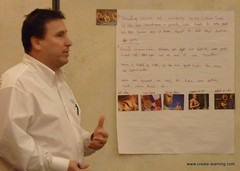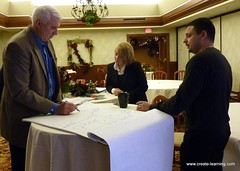The financial crisis turned traditional budgeting and strategic planning on its head. Now companies allow for more flexibility in drafting their plans.
CFO.com: Russ Banham
| Strategic Planning Meeeting (Photo credit: michaelcardus) |
The financial crisis and subsequent recession turned these efforts on their head, rendering almost every five-year plan into worthless scraps of paper. ... “For most of us, the financial crisis and its aftermath was a truly dynamic event that we had not experienced in our lifetimes before,” explains Ken Esch, partner in PwC’s private company service practice.
“
We’d never seen such change happen with such velocity, and we’d never realized just how connected we were to the global economy,” he adds. “It tested our ability to plan for the future.”
| Strategic Planning Meeeting (Photo credit: michaelcardus) |
Yet, as Steve Player, North America program director for the Beyond Budgeting Roundtable, points out, despite the constant winds of change, all organizations still must develop and act upon a strategic plan. “You have to have some idea of where you’re going,” Player asserts. “You need to establish what markets you’re going to compete in, which products you will produce, which services you will provide, and then posit out your strategy for winning.”
Both planning experts agree that the key to planning is keeping the plan flexible, nimbly adjusting it based on dynamic forecasts that suggest changes ahead, if not already afoot. As Player puts it, “You plan for what you think will happen, but then constantly subject the plan to scenario tests based on your changing assumptions.”
These assumptions might be the price of a barrel of oil, the risk of an extreme weather event, the impact
of potential currency fluctuations or the shifting economic conditions in Italy. In each case, a contingency plan is developed and kept at hand—just in case. The organizations that best assess these possibilities and expeditiously address them arguably are in a better competitive position than their peers.
| English: Created for the WMF strategic planning process (Photo credit: Wikipedia) |
Not all companies are taking such actions, however. “Businesses seem to be diverging on their approach to planning,” Esch says. “One camp continues to be uncertain as to what they ought to do in light of all these events occurring around the globe, and how they will impact their companies. They seem to be afraid to make commitments and big bets.”
The other camp has accepted that these dynamic events and changing times are the new normal. “They’re constantly figuring out how they’re going to operate in this new environment, placing bets on a different market or new product,” he adds. “Their planning is agile.”
As always, information is vital to the planning exercise. In many cases, such business intelligence is not hard to come by. “Companies that have been around for awhile already have a repository of historical data indicating what happened to the business the last time the economic cycle shifted or some unforeseen event occurred,” Esch notes. “Perhaps one part of the business suffered, but another part performed even better. That tells you something about where to allocate resources.”
Like Player, Esch does not advocate gutting the strategic five-year plan. Rather, he agrees that companies must write these plans not in ink, but in pencil. Keep an eraser handy.










No comments:
Post a Comment